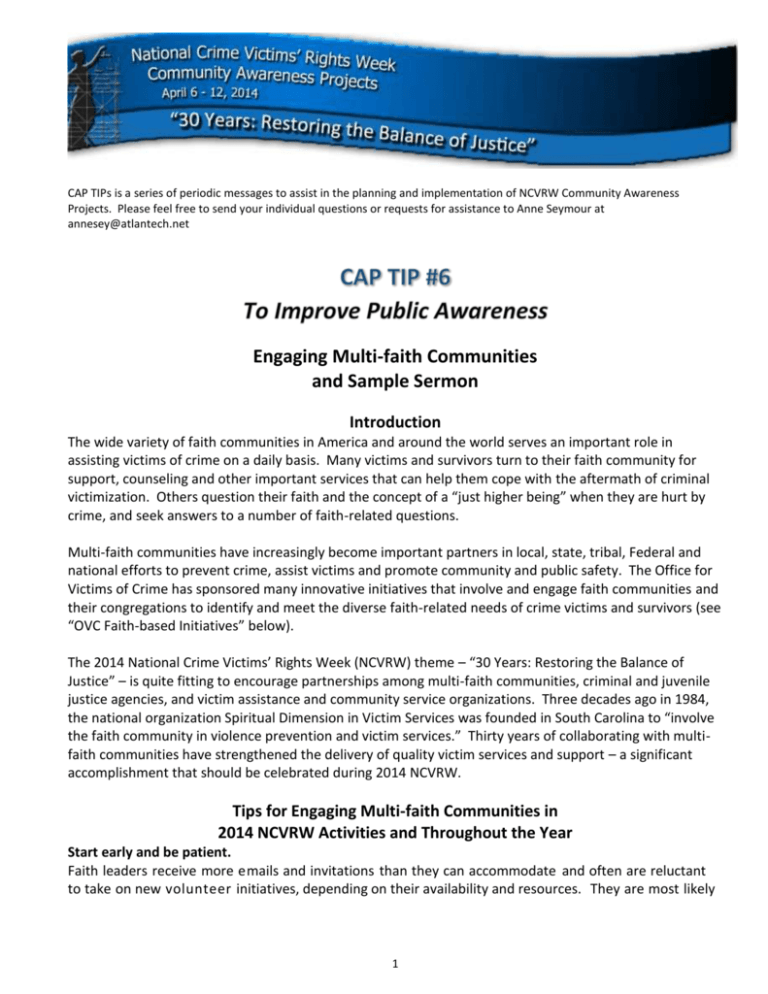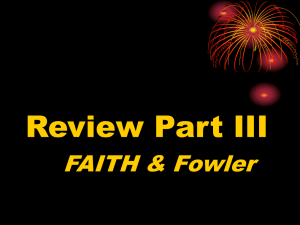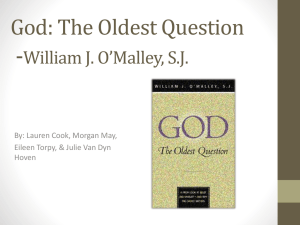CAP TIPS 1 - NCVRW Community Awareness Project
advertisement

CAP TIPs is a series of periodic messages to assist in the planning and implementation of NCVRW Community Awareness Projects. Please feel free to send your individual questions or requests for assistance to Anne Seymour at annesey@atlantech.net Engaging Multi-faith Communities and Sample Sermon Introduction The wide variety of faith communities in America and around the world serves an important role in assisting victims of crime on a daily basis. Many victims and survivors turn to their faith community for support, counseling and other important services that can help them cope with the aftermath of criminal victimization. Others question their faith and the concept of a “just higher being” when they are hurt by crime, and seek answers to a number of faith-related questions. Multi-faith communities have increasingly become important partners in local, state, tribal, Federal and national efforts to prevent crime, assist victims and promote community and public safety. The Office for Victims of Crime has sponsored many innovative initiatives that involve and engage faith communities and their congregations to identify and meet the diverse faith-related needs of crime victims and survivors (see “OVC Faith-based Initiatives” below). The 2014 National Crime Victims’ Rights Week (NCVRW) theme – “30 Years: Restoring the Balance of Justice” – is quite fitting to encourage partnerships among multi-faith communities, criminal and juvenile justice agencies, and victim assistance and community service organizations. Three decades ago in 1984, the national organization Spiritual Dimension in Victim Services was founded in South Carolina to “involve the faith community in violence prevention and victim services.” Thirty years of collaborating with multifaith communities have strengthened the delivery of quality victim services and support – a significant accomplishment that should be celebrated during 2014 NCVRW. Tips for Engaging Multi-faith Communities in 2014 NCVRW Activities and Throughout the Year Start early and be patient. Faith leaders receive more emails and invitations than they can accommodate and often are reluctant to take on new volunteer initiatives, depending on their availability and resources. They are most likely 1 to participate if they have been involved in the development of a program or project. It takes time to build trust, even among denominations or sub-groups of one faith. Start with a small group of representatives of various faiths who already are familiar with crime victims’ issues and services. They do not necessarily need to be faith leaders, but may be volunteers w i t h in the community to whom victims informally turn for help. This initial group should meet a few times in order to move from tolerance to mutual respect and appreciation of each other. Early meetings might offer the opportunity for each group to share basic information about their respective faiths, correct myths or misunderstandings, and identify common themes of peace and non-violence. The ultimate task of this group is to decide on a reasonable goal for commemorating 2014 NCVRW and identify interfaith members of a Steering Committee who can work together to achieve the goal. Develop a Steering Committee with commonalities. Most Steering Committee members will emerge from the initial planning group, and a few more key faith leaders may be added. While it would be ideal to bring together all faiths in your community, it is not likely to happen initially. Jews, Christians, and Muslims are likely to work well together because they share the same heritage. Buddhists and Hindus may work well together because of their common faith characteristics. Those who practice traditional Native American spirituality are accepting of other faith groups. If inter-denominational groups within Christianity or interfaith groups have already been developed in your community, that’s a good place to start. Diversify leadership. While one person may be identified to schedule meetings and plan logistics, all participants on the Steering Committee should have balanced and equal authority in all phases of program development and implementation. Decide what you want to accomplish. There is a wide range of options to engage multi-faith communities, for example: Providing sermons (see “Sample Sermon” in this CAP Tip) or teaching outlines to faith leaders who can address crime victims’ most important concerns and the 2014 NCVRW theme Developing newsletter or inserts for the faith communities’ worship bulletins depicting crime victimization, its impact, and where to go for help Providing copies of the posters included in the 2014 OVC NCVRW Resource Guide to faith institutions to prominently display in their facilities before and during NCVRW Creating a speakers’ bureau of crime victims and victim services providers who will speak to faith groups during 2014 NCVRW Developing a resource guide for cross-referrals a m o n g faith communities and victim assistance agencies Hosting an interfaith anti-violence forum or breakfast during NCVRW 2 Developing dating violence p re ven t io n materials for faith-based youth groups and organizations Educating faith communities about domestic violence screening tools for pre-marriage counseling programs in faith communities Providing guidelines for identifying and assisting victims of trafficking Sponsoring a victim/survivor memorial service that is spiritually-sensitive to all faiths in your community Partnering with correctional agencies to assist offenders and inmates who have personal histories involving trauma and/or victimization Providing theologically-based materials for each faith group that emphasize non-violence, compassion for victims, and offender accountability Creating a brochure outlining how members of the faith community can support victims of crime Conducting training about crime victim issues to faith communities Developing a spiritually-sensitive crisis response plan in the event of a community disaster Remember that an interfaith program is not a “melting pot” program. An interfaith program is more like a mosaic than a melting pot. It is not realistic to seek to reduce each faith to a common denominator. However, it is reasonable to focus on multiple manifestations and expressions of a common theme, such as peace or anti-violence. For example, Jews may pray to Yahweh for peace; Christians may pray for peace in the name of Jesus; and Muslims may pray for peace directly from the words of the Qu’ran to Allah. Hindus and Buddhists are more comfortable with meditation than prayer. Never expect all groups to pray the same way. Meet at different places to develop your NCVRW strategy. The sites of various committee meetings should rotate among the faiths, perhaps at a church one time and a synagogue, temple, or mosque the next. The hosting faith institution can provide a brief overview of its faith and any efforts it has sponsored to assist victims of crime. Likewise, if the program is to be an annual one, such as an NCVRW Interfaith Memorial Service for Victims of Crime, the actual site of the service may change from year to year. Don’t expect universal participation. An email or invitation to every faith institution in your community is not likely to be effective. Rely on Steering Committee members to distribute information about the program within their own faith groups; these personal contacts are essential for success. Each can introduce the program to their youth groups, congregations, service agencies, seminaries, and faith leaders through personally signed cover letters, emails or other direct personal contacts. 3 Office for Victims of Crime Faith-based Initiatives While many OVC initiatives and products integrate collaboration with multi-faith communities within their content (please visit www.ovc.gov for additional information and resources), the six documents below may be particularly helpful in framing issues of mutual concern between victim assistance organizations and multi-faith communities: Vision 21: Transforming Victim Services Final Report (2014) The “Vision 21: Transforming Victim Services” initiative was launched by OVC in fall 2010 to expand the vision and impact of the crime victim assistance field. This Final Report provides a set of findings and broad recommendations, informed by stakeholder forums and literature reviews, that forms a framework for strategic, transformative change. The Final Report outlines ways the field can overcome the obstacles it faces and change how it meets victims' needs and addresses those who perpetrate crime. http://ovc.ncjrs.gov/vision21/pdfs/Vision21_Report.pdf Good Samaritans: Volunteers Helping Victims Program Handbook and Training Guide (2009) This online guide is designed for prosecutors, law enforcement agencies, community groups, and faith-based organizations interested in using volunteers to expand their outreach to crime victims. A product of the Good Samaritans program in Mobile, Alabama, it provides guidance for replicating the program in other communities, as Mobile has done, and training volunteers to provide emergency services to victims including home repair, compassionate support, and referrals to other services. http://www.ovc.gov/publications/infores/Good_Samaritans/welcome.html Building Victim Assistance Networks with Faith Communities This document summarizes how the Vermont Center for Crime Victim Services, as part of the Office for Victims of Crime's Victim Services 2000 demonstration project, built and used relationships with the faith community to improve victim services. It specifically addresses the need for collaboration; victim needs from a faith-based perspective; elements of collaboration; “lessons learned”; and issues unique to faith-based victim assistance. http://www.ojp.usdoj.gov/ovc/publications/infores/faith_based_vict_asst/pfv.html Partnering with Faith Communities to Provide Elder Fraud Prevention, Intervention and Victim Services (2006) This bulletin highlights the innovative collaboration between the Denver District Attorney's Office and over 200 faith community partners in Denver. It provides key information and "lessons learned" that may be useful to other communities across the Nation that are interested in developing a similar initiative. http://www.ojp.usdoj.gov/ovc/publications/bulletins/elderfraud_case/pfv.html Faith Community Involvement in Task Forces and Community Initiatives This document highlights “lessons learned” from the engagement of faith communities in victim assistance collaborations and initiatives. http://www.ojp.usdoj.gov/ovc/publications/infores/faith_based_vict_asst/faith_community.html 4 Spiritual Dimension in Victim Services Manual for Congregations and Clergy – Special Edition for Military Chaplains This historic curriculum includes information about how faith communities can assist different types of crime victims, along with tips about how to conduct a clergy training event. https://www.ncjrs.gov/ovc_archives/reports/clergy/welcome.html Tips for Identifying Multi-faith Communities in Your Jurisdiction A good place to start is to ask members of your NCVRW Planning Committee to identify and provide contact information for the faith communities and institutions where they worship. Personal relationships with faith leaders are an important “first step” to engage them in your 2014 NCVRW activities. There are a variety of websites that ease the process of identifying different faith communities by denomination, location, and programs and services offered. The following websites are provided only as references and not as endorsements: Beliefnet (www.beliefnet.com) offers a user-friendly website that provides information about a wide variety of faith denominations, including but not limited to: Atheism Judaism Buddhism Mormonism Catholicism Religious Society of Friends (Quakers) Christianity Scientology Christian Science Seventh Day Adventism Hinduism Sikhism Islam Taoism Find a Church (www.findachurch.com) is on online global directory of nearly 38,000 faith communities, which allows you to search its database by denomination, language, worship style and special needs, among other criteria. The Pluralism Project sponsored by Harvard University (www.pluralism.org) offers links to a variety of faith denominations and religious centers within the United States. The National Council of Churches (www.nationalcouncilofchurches.us) has a page within its extensive website devoted specifically to “justice and advocacy.” Links to local synagogues across the United States can be found at www.mykaddish.com. The Judaism 101 website (www.jewfaq.org) is an “online encyclopedia of Judaism” that also offers links to a number of synagogues, shuls and temples within the United States. Islamicity (www.islamicity.com) provides extensive information and resources about Islam, as well as contact information for mosques by state and zip code. 5 The World Buddhist Directory (www.buddhanet.info/wbd) allows you to identify Buddhist temples by clicking on your state within a map of the United States. Sikh temples nationwide can be identified by region at www.gurdwara.us. Contact and location information for Hindu temples in the United States can be found at www.hindutemples.us. Sample Sermon One of the most requested resources from previous CAP recipients is a “sample sermon” that can be provided to leaders of multi-faith communities. The following sample sermon that reflects the 2014 NCVRW theme was written by the Reverend Richard Lord and Janice Harris Lord, a long-time national victim advocate: The Desert Shall Bloom “The wilderness and the dry land shall be glad, and the desert shall rejoice and bloom; like the crocus it shall blossom abundantly, and rejoice with joy and singing.” Isaiah 35:1,2 Jerusalem was destroyed. The temple burned. The descendants of David imprisoned. All symbols of meaning and hope for Israel were gone. This is not a mythological story. It is a historical event that painfully unfolded before the Hebrews’ eyes. In 587 BC, the Babylonian army demolished the moral and psychological foundations of Israel. Amazingly, during this time of utter despair, Israel’s prophets spoke of restoration. They pointed to the time when the Hebrews would again rejoice and sing in Jerusalem’s streets. The temple would be rebuilt where praise and prayers would be offered to the One who continually renews life. A moral and political order would be reestablished among God’s people. Sometimes, in the midst of despair, a few people arise to pronounce a vision of brokenness becoming mended. Surprisingly, people respond and begin the hard work of restoring. God promised new life in a time of barrenness, but the people had to do their part. God did not haul the stones to rebuild the walls of the city. The men did. The women prepared the food. The children learned their prayers. But if they had not struggled with those boulders, our Jewish, Christian, and Muslim monotheistic traditions would not be alive today. We have inherited a noble tradition of justice not from only those who formed our country but from the ancient Greeks and Hebrews whose wisdom was at its source. Our country’s founders were not the first to proclaim that “all men are created equal.” They did not dream up the values that underpinned the Constitution. They simply proclaimed that “We the people ... ordain and establish” it. Today, our task is not to look back to those who created our rich tradition with admiration, but to renew our commitment to restoration of the fuller sense of the ideas of the noble prophets of long ago. In the grind of ordinary life, those ideas were never fully realized. We must nurture, enhance, fulfill, and 6 further weave into the fabric of our everyday life their vision of equality and justice for all. Some of us remember when drunk driving was a traffic offense, not a crime. Margaret Mitchell, author of Gone With the Wind, was killed by a drunk driver who never spent a night in jail. We remember when a burglary victim was told, “Tough luck! Keep your door locked next time.” We remember when parents of a rape victim prayed for her forgiveness rather than calling the police. All too recently, if criminals or juvenile delinquents paid a price for their crimes, it went to the state rather than to direct restitution to the victim. Younger professionals and volunteers in our Nation’s crime victim assistance field find it hard to believe the stories of injustices that their elders tell. Reminiscing about our history isn’t a bad thing, but our task now is to recognize and work together to mitigate the weaknesses in our systems of justice and victim service delivery today. We look to the past, not simply with respect, but to gain clarity about who we can become. Thirty years from now, we want new victim assistance professionals and volunteers to look back to our day – in 2014 – and find our stories hard to believe. The prophets’ promise to the Hebrews that the desert of their lives would bloom again was not only a promise of what God was going to do. It was also a call to action. We can easily become discouraged. So much resistance and indifference can become depressing. But that moment of despair is precisely when we hear a Word from beyond ourselves. We will never completely realize the vision, but we consistently move toward it. Guided by the vision, our work in crime victim assistance and community safety is never a “job.” It is a calling. Spiritually-sensitive Caregiving An excellent book that highlights key aspects of six faiths – Buddhism, Christianity, Hinduism, Islam, Judaism and Native American culture – is Spiritually Sensitive Caregiving: A Multifaith Handbook. Coauthored by four respected national victim advocates, this book describes each faith’s ritual beliefs and rituals, death issues and justice-related issues. It can be ordered from Amazon at www.amazon.com. For More Information Please contact National Crime Victims’ Rights Week Community Awareness Project Consultant Anne Seymour via email at annesey@atlantech.net; or by telephone at 202.547.1732. 7








